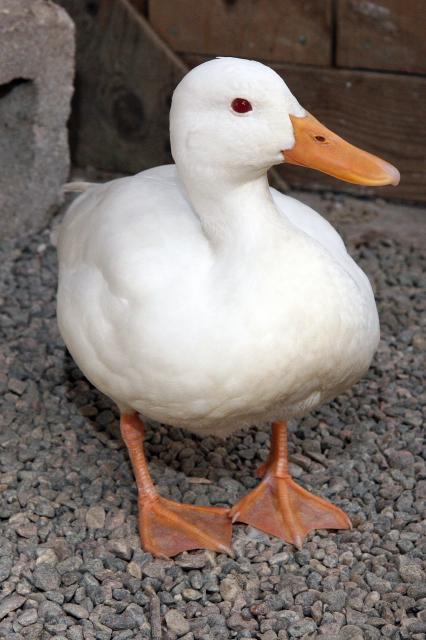- Jan 31, 2010
- 250
- 10
- 189
The following basic information has been compiled for those interested in colour genetics with the hope that it assists understanding. As detail has always eluded myself (& I'm a colour genetics novice too) there will be error so any corrections will be most welcomed. I start from the beginning because that helps with understanding. If you would like to contribute a "suitable" example colour/breed photo (preferably side shots) then please post a link to it in this thread. If you would like to see colour/pattern/genotypes added simply let it be known in this thread.
The cells; Somatic & Gamete, plus brief introduction to Chromosomes & Genes
Ducks are multicellular organisms with many different types of cells making up the different tissues of their bodies, for example, red blood cells, white blood cells, bone cells, skin cells, liver cells, muscle cells, & sperm & ova (egg) cells etc. For ease of understanding these cells can be grouped into two main categories; Somatic cells (eg liver, muscle, skin, bone etc), & Gamete cells (ie sperm & ovum (or eggs)). See diagrams below:-
Blue/yellow = somatic cells. Red = sperm cells (in testicles)

Pink/yellow = somatic cells. Red = egg (ova) cells (in ovaries)

Within both groups of cells (somatic & gamete) are nuclei, & within the nuclei are the Chromosomes (ie long strands of DNA). Chromosomes are composed (in part) of many genes, ie, units of heredity that code for all of the genetic traits in the living organism, for example, shape, size, & colour. In Ducks, Somatic cells have 80 chromosomes or 40 pair, while the Gametes only have 40 chromosomes in total ie only one chromosome from each pair. See diagram below:-

The Somatic cells divide in such a way (Mitosis) that they retain two copies of each chromosome (diploid number) ie the chromosomes occur in homologous pairs. One member of each pair comes from the father, while the other member of each pair comes from the mother:-

Some pairs of chromosomes in somatic cells: taken from http://commons.wikimedia.org/wiki/File:Karyotype_color_chromosomes_white_background.png)

But the Gametes have divided in such a way (Meiosis) that they each only have one copy of each pair (haploid number) of chromosomes that usually occur in the somatic cells:-

How the Body Works : Gamete Cells
And a diagram of a human sperm & egg with their half compliments of chromosomes for example only: taken from http://members.cox.net/amgough/Fanconi-genetics-genetics-primer.htm

While many of the specialized somatic cells continue to divide & maintain the various body tissues, it is the gametes which transfer the genetic material from both parents to the new life via chromosomes/genes. When the gametes (sperm & egg) fuse @ fertilisation, the diploid number or pairs of chromosomes are again restored in the first new cell (Zygote) of the new life. See digram below:-

Gene & Chromosome pairs, plus brief introduction to Dominant/Recessive states
Genes, like chromosomes, usually occur in pairs. Genes which occur @ the same position (locus) on a pair of homologous chromosomes are called alleles. An allele is one of two or more alternative forms of a gene @ any given locus. See diagram below:-

Alleles which are of the same form & code for the same trait are said to be homozygous, while Alleles which are of a different form & code for different traits are said to be heterozygous. See diagram below:-

Some alleles are more dominant than others. See tutorial & diagrams below:-
Incomplete Dominance and Codominance - A Quick Tutorial
For the trait to express (be seen) recessive alleles need to be in the homozygous state (except for sex-linked genes in the female duck). Homozygous recessive white in Mallard derived birds for example:-

But in the white heterozygote, the more dominant wild-type or "not-white" (C+) gene will express over its recessive white allele (c):-

Biology: Mendel: Alternate Alleles
Sex determining Chromosomes, Autosomes, & Sex-Linked Inheritance
Chromosomes are divided into Autosomal Chromosomes & Sex-determining Chromosomes. Autosomal chromosomes are non sex-determining & are all chromosomes that aren't Z or w. The sex-determining chromosomes (Z & w) are sex-determining in that if a new life has only inherited Z sex chromosomes it will be male, but if the new life has inherited both Z & w sex chromosomes it will be female. Male ducks (birds) can only pass Z sex chromosomes to their progeny, both male & female, because being genetically ZZ, they only have Z sex chromosomes to give. Female ducks (birds) can pass on either Z or w sex chromosomes to their progeny because being genetically Zw, they have both Z & w sex chromosomes to give. As such, the mother determines the sex of her young because if she passes on a Z sex chromosome to a duckling it will be a boy (ZZ, Z from dad & Z from mom), but if the mother passes a small w sex chromosome to a duckling it will be a girl (Zw, Z from dad & w from mum).
Paired sex determining chromosomes for ducks (females)

Paired sex determining chromosomes for drakes

Comparison sample of a drake & ducks diploid chromosomes including sex-determining pairs:-

Sex-determining chromosome inheritance as per diagram below:-

The female is "hemizygous" for the two identified sex-linked colour genes/alleles (bu & Bu+, & d & D+)! This is because the Z sex chromosome inherited from the father has loci for these genes/alleles, but the w sex chromosome inherited from the mother doesn't have the same loci (-), so the d/D+, bu/Bu+ genes/alleles can't be inherited by a daughter from their mothers on the w sex chromosome. Although a female duck does have a pair of sex chromosomes (Zw), she can only ever have one sex linked gene @ each locus for Bu & D. See diagram below:-

Below are the pair of sex chromosomes for a duck (Zw). On the Z chromosome you will see the recessive brown dilution gene. We know from above that she passes her Z chromosomes onto her sons & her small w chromosomes onto her daughters, so all of her sons will inherit a recessive brown dilution gene but none of her daughters will because the small w chromosomes that she passes to them doesn't have the locus for a recessive brown gene. Although this duck only has the one recessive brown gene (d) on her sex chromosomes the colour will still express because there is no competition from the dominant "not brown" allele (D+).

Below are a pair of sex chromosomes from a drake (ZZ). Here you will see that both Z chromosomes have the recessive brown dilution gene. He only has Z chromosomes to give & will pass them plus their recessive brown dilution gene onto both male & female progeny.

All ducklings produced from the above two "pure for recessive brown dilution gene" birds will inherit the gene. Being a recessive, the males need two doses for the trait to express, while the females, being hemizygous, only require the one dose for the trait to express.

The following pair of birds are different though. This time, the drake is still pure for the sex-linked recessive brown dilution gene (d/d), but the duck has its allele "not brown" or wild-type (D+/-):-
The d/d drake

The D+/- duck

The diagram below shows the sex-linked qualities of such a mating. Female progeny inherit a brown-dilution gene (d) from their father & being hemizygous, nothing (-) from their mother. The colour trait brown will express (if not hidden by white). Male progeny inherit a brown dilution gene (d) from their father, but also the not brown allele (D+) from their mother. Being the dominant allele, "D+" will suppress the action of its recessive brown allele "d", so, drakelets will not express the trait for brown, but they will carry one recessive brown dilution gene hidden.

And some photos to help illustrate:-

Working with Colour/Pattern Genes of the Mallard derived bird
The genes for colour/pattern in Mallard derived birds follow. They include the wild-type (those genes found in the original wild mallard) as denoted by the (+), & mutations. The alleles have been grouped together eg M+, MR, & md are alleles (according to their loci), with upper case denoting the more dominant allele:-
M+ = Wild-type Mallard
MR = Restricted Mallard
md = Dusky mallard
Li+ = Dark Phase
li = Light Phase
lih = Harlequin Phase
so+ = wild-type
So = Sooty; darkens dusky & wild pattern plumage
e+ = not black
E = Extended Black
bl+ = not blue
Bl = Blue Dilution
D+ = not brown
d = Brown Dilution (sex-linked) {? sex-linked buff dilution allele, ie, wild-type > brown dilution > buff dilution}
Bu+ = not buff
bu = Buff Dilution (sex-linked) {? sex-linked brown dilution allele, ie, wild-type > brown dilution > buff dilution}
C+ = not white
c = recessive white
s+ = not bibbed
S = dominant bib
B+ = not bibbed
b = recessive bib
W+ = not white primaries
w = white primaries
r+ = not pied
R = pied pattern
y+ = normal yellow skin & bill colour
Y = white skin & bill
sd+ = not solid dark bill
Sd = solid dark bill colour {? in the presence of dark phase genes only, ie, light/harlequin phase gene combinations epistatic to "heterozygous" Sd/sd+ resulting in birds exhibiting light (generally) coloured bills?}
The full sequence of colour/pattern genes for a Mallard drake that is pure for wild-type may look something like this:-
M+/M+, Li+/Li+, e+/e+, bl+/bl+, D+/D+, Bu+/Bu+, C+/C+, s+/s+, B+/B+, W+/W+, r+/r+, y+/y+.
And the full sequence of colour/pattern genes for a Mallard duck that is pure for wild-type may look something like this:-
M+/M+, Li+/Li+, e+/e+, bl+/bl+, D+/-, Bu+/-, C+/C+, s+/s+, B+/B+, W+/W+, r+/r+, y+/y+.
Often when discussing the colour/pattern genotype of birds we dont see or use the full sequence of genes, but rather, a shorthand version. So instead of for example (drake):-
md/md, Li+/Li+, e+/e+, Bl/bl+, d/d, bu/bu, C+/C+, s+/s+, B+/B+, W+/W+, r+/r+, y+/y+
we may only see:-
md/md, Bl/bl+, d/d, bu/bu
Why? Because only the genes that deviate from the wild-type, ie, the mutations, really need to be listed as the remainder of the colour genotype is assumed to be wild-type.
When we see strings of letters like those above we are simply looking @ genes on chromosomes. For example, M+/md represents a pair of genes on a pair of chromosomes @ a specific locus seperated by a forward slash (/). One chromosome/gene has been inherited from one parent & the other chromosome/gene has been inherited from the other parent ie M+ is the wild-type gene (on its chromosome) inherited from one parent, & md is a mutated gene inherited from the other parent (on its chromosome). This pair of genes are alleles because they occur @ the same position (locus) on the pair of homologous chromosomes. See diagram below:-

The Mallard Series Alleles (wild-type = M+, restricted = M^R, dusky = m^d)
The Mallard series alleles influence pattern/colour as per the following:-
Wild-Type Mallard (M+); ducklings exhibit the typical camouflage pattern as seen in the wild-type young including ocular stripes (eye-lines), four dorsal spots & ventral yellow. The dorsal surface down colour has been described as "olivacious black". As adults, the female typically has the eye-stripes & brown pencilled plumage, while the drake has the full hood, claret breast, & neck ring in nuptial plumage.
Restricted Mallard (M^R); most evident in the ducklings down, the restricted gene restricts superficial dorsal surface dark down pigmentation to the head (mohark) & tail areas with some variation occuring. Investigating deeper into the down will show a darker undercolour. In the adults the main variation from wild-type is seen in the wing fronts/bows (smaller coverts) with more white being evident.
Dusky Mallard (m^d); dusky duckling down pattern varies considerably from the wild-type mallard & restricted mallard above. Dark pigment is extended uniformly over the dorsal surface with no evidence of facial markings & dorsal spots being evident. Ventral surface areas, although lighter, still exhibit colour other than dull yellow, with bill & legs being dark-ish also. As adults, the males in nuptial plumage lack claret breast & neck rings (dark phase), & the speculum (iridescent wing bars) are obscured & less clearly defined. Dusky females (& males in eclipse plumage) lack the eye-stripes, & both sexes are pigmented underwing (dark & light phase).
Mallard Series Alleles discussed in more detail here (PDF) http://www.genetics.org/cgi/reprint/19/4/310.pdf
The Phase Alleles (dark phase = Li+, light phase = li, harlequin phase = li^h)
Generally, the effect of the phase alleles(Li+, li, lih) on the mallard series alleles (M+, MR, md) is to progressively lighten/brighten, or increase the amount of white, usually very noticable on the females, but other colour/pattern traits are also altered. Some examples using the wild-type mallard (M+) gene & each of the phase alleles to demonstrate:-
M+/M+, Li+/Li+ = a dark phase wild-type mallard eg Rouen or Grey Mallard. Typically the darkest females http://www.feathersite.com/Poultry/Ducks/Rouens/BRKRouens.html
M+/M+, li/li = light phase wild-type mallard eg Trout Runner or Rouen Claire. Lighter than above http://www.feathersite.com/Poultry/Ducks/RouenClair/BRKRouenClair.html
M+/M+, li/lih (theoretically) = light/harlequin phase wild-type mallard eg Australian Spotted. The lightest/brightest of the three http://www.avianweb.com/australianspottedducks.html
I usually think of the mallard series alleles (MR, M+, md) & the phase alleles (Li+, li, lih) as the base genes & those I begin with when building/creating the colour/pattern of a bird. They can occur in any combination resulting in the varied & "off" phenotypes that we see when impure. The mutations @ the other loci when added contribute to the wonderful array of colour & pattern in mallard derives breeds/varieties.
A few examples using base series (MR, M+, md) & phase (Li+, li, lih) genes to illustrate. Remember, when using shorthand those gene pairs not listed are assumed to be wild-type:-
1/ M+/M+, Li+/Li+ = dark-phase wild-type mallard eg Rouen
2/ M+/M+, li/li = light-phase wild-type mallard eg Trout
3/ M+/M+, lih/lih = harlequin-phase wild-type mallard eg Snowy (per American standard)
4/ MR/MR, Li+/Li+ = non-standard genotype (off-coloured)
5/ MR/MR, li/li = light-phase restricted mallard eg Appleyard
6/ MR/MR, lih/lih = non-standard genotype (off-coloured)
7/ md/md, Li+/Li+ = dark-phase dusky mallard eg Dark Campbell
8/ md/md, li/li = non-standard genotype (off-coloured)
9/ md/md, lih/lih = harlequin-phase dusky mallard eg Abacot Ranger
Now add diluting/pattern modifying genes to a couple of them for example:-
1/ M+/M+, li/li, Bl/Bl = apricot/buff light-phase wild-type mallard eg Saxony
2/ md/md, Li+/Li+, d/d (d/-) = brown dark-phase dusky mallard eg Kharki Campbell
3/ M+/M+, Li+/Li+, Bl/bl+ = blue dark-phase wild-type mallard eg Blue Fawn
4/ md/md, Li+/Li+, d/d (d/-), R/R = brown pied dark-phase dusky mallard eg Fawn & White Runner
Purity & Impurity
The colour/pattern genes which exist in any given bird will influence what we see (phenotype) as regards colour/pattern. When pure for a certain breed colour/pattern, then we should see what we have become accustomed to seeing for that breed. But many times we will see some small variation regardless, possibly due to variable expression of the gene/s or the influence of unknown minor modifiers. Birds that are impure @ one or more loci may also express in "off" colours/patterns. Lets look @ a couple of examples of pure & impure colour genotypes starting with the pure wild-type bird ie the wild Mallard or Rouen. All mutations are in red for ease of identification.
A wild-type coloured/patterned drakes genotype should as we know it be:-
M+/M+, Li+/Li+, e+/e+, bl+/bl+, D+/D+, Bu+/Bu+, C+/C+, s+/s+, B+/B+, W+/W+, r+/r+, y+/y+.
All paired genes in the above genotype are wild-type as designated by the (+) symbol. This bird is pure @ all loci for paired genes because each pair are the same (homozygous), eg M+/M+. There is nothing hidden because all recessive pairs are pure so the trait/s should express, eg e+/e+.
But what about a bird who is impure @ one or more loci? The following drake genotype is impure @ two loci! He is heterozygous Li+/li & C+/c so what will he look like? According to theory, he should really look much like the wild-type Mallard drake above. Both mutations li & c are recessive to their alleles Li+ & C+ so should have little to no influence on phenotype. If we cant see them (heterozygous recessives) but they are there then we could say that they are hidden:-
M+/M+, Li+/li, e+/e+, bl+/bl+, D+/D+, Bu+/Bu+, C+/c, s+/s+, B+/B+, W+/W+, r+/r+, y+/y+.
The following drake is pure @ all loci including the recessive white mutation c, ie, homozygous c/c. When pure, the recessive white gene either inhibits the production of colour (eumelanin & pheomelanin), or it prevents the colour from getting into the feather, so we end up with a bird with no colour, ie a pure for white bird:-
M+/M+, Li+/Li+, e+/e+, bl+/bl+, D+/D+, Bu+/Bu+, c/c, s+/s+, B+/B+, W+/W+, r+/r+, y+/y+.
The following drake has mutations @ two loci! Firstly, he is pure (homozygous) for the extended black mutation gene E, & secondly, he is impure (heterozygous) for the blue dilution mutation gene Bl, so what will he look like? The extended black gene will extend black pigment (eumelanin) throughout the whole bird, so the wild-type coloured/patterned mallard will be turned into a black bird. But he wont remain black because of the blue dilution gene! The blue dilution gene is incompletely dominant, ie, it doesnt completely get rid of the black but only reduces its intensity by inhibiting the amount of eumalanin that gets into the feather, so we end up with a diluted black ie blue/grey:-
M+/M+, Li+/Li+, E/E, Bl/bl+, D+/D+, Bu+/Bu+, C+/C+, s+/s+, B+/B+, W+/W+, r+/r+, y+/y+.
Calculating Probable Outcomes Using Punnett Squares
Punnett Squares are a fun & easy way to calculate the probable trait outcomes of your breeding programs if you know the typical genes & their behaviour in the breeds you keep. A couple of examples using Punnett Squares may help. Mutations will be highlighted in red.
Lets say that we mate a wild-type Mallard drake to a Blue Fawn Mallard duck:-
Drake = M+/M+, Li+/Li+, e+/e+, bl+/bl+, D+/D+, Bu+/Bu+, C+/C+, s+/s+, B+/B+, W+/W+, r+/r+, y+/y+. :-
Duck = M+/M+, Li+/Li+, e+/e+, Bl/bl+, D+/-, Bu+/-, C+/C+, s+/s+, B+/B+, W+/W+, r+/r+, y+/y+.
We want to work out what colours we will get from this cross & we only need to consider the blue (Bl) & the not-blue (bl+) genes (alleles). Using our Punnett Square we can put the drakes alleles down the left hand side & the ducks alleles across the top:-

One more example; we breed together two birds that both appear to be pure wild-type Mallards but each carries hidden (heterozygous) a recessive white gene (c):-
Drake = M+/M+, Li+/Li+, e+/e+, bl+/bl+, D+/D+, Bu+/Bu+, C+/c, s+/s+, B+/B+, W+/W+, r+/r+, y+/y+.
Duck = M+/M+, Li+/Li+, e+/e+, bl+/bl+, D+/-, Bu+/-, C+/c, s+/s+, B+/B+, W+/W+, r+/r+, y+/y+.
Using the Punnett Square we learn that 25% of progeny will be pure white, 25% pure for wild-type, & 50% will appear wild-type coloured/patterned birds but will carry heterozygous recessive white hidden.

So you see, if we know what colour/pattern genes are in our parent birds & we know how these effect colour/pattern, we can calculate probable outcomes using the Punnett Sqare.
These Youtube clips are also very helpful:-
Gregor Mendel's Punnett Squares
Mendelian Genetics - A Quick Tutorial
Incomplete Dominance and Codominance - A Quick Tutorial
http://www.schooltrainer.com/study-material/biology/punnett-square-fun.html
Some Genotypes with Photo examples
Following are some photos of birds & their theorised genotypes. All mutations are in red for ease of identification. It is worth being aware that genotypes may vary somewhat between breeds with the same hobby name in different countries. Quality for type may not be to standard for some example birds; colour & pattern are the desired features portrayed!
Wild-type Mallard Drake (grey)
M+/M+, Li+/Li+, e+/e+, bl+/bl+, D+/D+, Bu+/Bu+, C+/C+, s+/s+, B+/B+, W+/W+, r+/r+, y+/y+.

Wild-type Mallard Duck (grey)
M+/M+, Li+/Li+, e+/e+, bl+/bl+, D+/-, Bu+/-, C+/C+, s+/s+, B+/B+, W+/W+, r+/r+, y+/y+.

Kharki Campbell Drake (dark phase dusky + brown dilution)
md/md, Li+/Li+, e+/e+, bl+/bl+, d/d, Bu+/Bu+, C+/C+, s+/s+, B+/B+, W+/W+, r+/r+, y+/y+.

Kharki Campbell Duck (dark phase dusky + brown dilution)
md/md, Li+/Li+, e+/e+, bl+/bl+, d/-, Bu+/-, C+/C+, s+/s+, B+/B+, W+/W+, r+/r+, y+/y+.

Dark Campbell Drake (dark phase dusky) (this bird = D+/d)
md/md, Li+/Li+, e+/e+, bl+/bl+, D+/D+, Bu+/Bu+, C+/C+, s+/s+, B+/B+, W+/W+, r+/r+, y+/y+.
Dark Campbell Duck (dark phase dusky)
md/md, Li+/Li+, e+/e+, bl+/bl+, D+/-, Bu+/-, C+/C+, s+/s+, B+/B+, W+/W+, r+/r+, y+/y+.
Fawn & White Runners (dark phase dusky + brown dilution + runner pattern (USA = add homo blue))
md/md, Li+/Li+, e+/e+, bl+/bl+, d/d, (d/-), Bu+/-, C+/C+, s+/s+, B+/B+, W+/W+, R/R, y+/y+.

With thanks to Roova
Silver Appleyard Drake (light phase resticted mallard)
MR/MR, li/li, e+/e+, bl+/bl+, D+/D+, Bu+/Bu+, C+/C+, s+/s+, B+/B+, W+/W+, r+/r+, y+/y+.

Silver Appleyard Duck (light phase resticted mallard)
MR/MR, li/li, e+/e+, bl+/bl+, D+/-, Bu+/-, C+/C+, s+/s+, B+/B+, W+/W+, r+/r+, y+/y+.

Saxony Drake (light phase wild-type mallard + homo blue dilution)
M+/M+, li/li, e+/e+, Bl/Bl, D+/D+, Bu+/Bu+, C+/C+, s+/s+, B+/B+, W+/W+, r+/r+, y+/y+.

Saxony Duck (light phase wild-type mallard + homo blue dilution)
M+/M+, li/li, e+/e+, Bl/Bl, D+/-, Bu+/-, C+/C+, s+/s+, B+/B+, W+/W+, r+/r+, y+/y+.

Trout (light phase wild-type mallard)
M+/M+, li/li, e+/e+, bl+/bl+, D+/D+, Bu+/Bu+, C+/C+, s+/s+, B+/B+, W+/W+, r+/r+, y+/y+.
Photo wanted
Blue Trout (light phase wild-type mallard + hetero blue dilution)
M+/M+, li/li, e+/e+, Bl/bl+, D+/D+, Bu+/Bu+, C+/C+, s+/s+, B+/B+, W+/W+, r+/r+, y+/y+.

Blue Fawn (dark phase wild-type mallard + hetero blue dilution) (these are M+/m^d, Li+/li, Bl/bl+)
M+/M+, Li+/Li+, e+/e+, Bl/bl+, D+/D+, Bu+/Bu+, C+/C+, s+/s+, B+/B+, W+/W+, r+/r+, y+/y+.

Pastel (dark phase wild-type mallard + homo blue dilution)
M+/M+, Li+/Li+, e+/e+, Bl/Bl, D+/D+, Bu+/Bu+, C+/C+, s+/s+, B+/B+, W+/W+, r+/r+, y+/y+.
Photo wanted
Harlequin (harlequin phase dusky)
md/md, lih/lih, e+/e+, bl+/bl+, D+/D+, Bu+/Bu+, C+/C+, s+/s+, B+/B+, W+/W+, r+/r+, y+/y+.
Photo wanted
Harlequin (harlequin phase dusky + brown dilution)
md/md, lih/lih, e+/e+, bl+/bl+, d/d, (d/-), Bu+/Bu+, C+/C+, s+/s+, B+/B+, W+/W+, r+/r+, y+/y+.
Photo wanted
Buff Orpington (dark phase dusky + brown, buff, + hetero blue dilution)
md/md, Li+/Li+, e+/e+, Bl/bl+, d/d, (d/-), bu/bu, (bu/-), C+/C+, s+/s+, B+/B+, W+/W+, r+/r+, y+/y+.
Photo wanted
Blue (extended black + hetero blue dilution)
E/E, Bl/bl+, D+/D+, Bu+/Bu+, C+/C+, s+/s+, B+/B+, W+/W+, r+/r+, y+/y+.
Photo wanted
Silver/Splash (extended black + homo blue dilution)
E/E, Bl/Bl, D+/D+, Bu+/Bu+, C+/C+, s+/s+, B+/B+, W+/W+, r+/r+, y+/y+.
Photo wanted
Chocolate (extended black + sex-linked brown dilution)
E/E, bl+/bl+, d/d, (d/-), Bu+/Bu+, C+/C+, s+/s+, B+/B+, W+/W+, r+/r+, y+/y+.

Bibbed (any colour + gene for bibbing)
M+/M+, Li+/Li+, e+/e+, bl+/bl+, D+/D+, Bu+/Bu+, C+/C+, S/S, B+/B+, W+/W+, r+/r+, y+/y+.
Photo wanted
Runner Pattern (any colour + pied/runner pattern gene)
md/md, Li+/Li+, e+/e+, bl+/bl+, d/d, (d/-), Bu+/Bu+, C+/C+, s+/s+, B+/B+, W+/W+, R/R, y+/y+.
Photo wanted
Magpie Pattern (any colour + pied/runner pattern + bibbed genes)
E/E, bl+/bl+, D+/D+, Bu+/Bu+, C+/C+, S/S, B+/B+, W+/W+, R/R, y+/y+.
Photo wanted
White
Epistatic to "colour/pattern" when homozygous. With birds that are pure for the recessive white gene it doesn't matter what "colour" or "pattern" genes exist because the expression of both will be inhibited, hence, a white (no colour) plumaged bird will result.
c/c.
Photo wanted
Black
Extended black will turn all pigmented areas to black. Both homozygotes & heterozygotes are affected (although unsure as to just how completely heterozygotes are affected?). Homozygous recessive white (c/c) will turn a black bird to white. Diluters & Pattern genes will influence colour/pattern.
E/E, bl+/bl+, D+/D+, Bu+/Bu+, C+/C+, s+/s+, B+/B+, W+/W+, r+/r+, y+/y+.

References
"Poultry breeding and genetics", By Roy D. Crawford, pp 381-387.
Poultry Genetics for the Nonprofessional, Sellers family http://sellers.kippenjungle.nl/page0.html
http://kippenjungle.nl/Overzicht.htm#kipcalculator
"Mosbys Medical, Nursing, & Allied Health Dictionary", 1994
"Stories Guide to Raising Ducks", Holderread, 2001.
http://www.ansi.okstate.edu/resource-room/genetics/all/chromosome.htm
"Colour Breeding in Domestic Ducks", Mike & Chris Ashton, 2007
The Domestic Duck", Chris & Mike Ashton, 2008
http://www.genetics.com.au/pdf/factsheets/fs01.pdf
http://www.ansi.okstate.edu/resources/genetic/diploid-chromosome-numbers-in-some-familiar-animals
"Biology: Concepts & Aplications", by Cecie Starr, Wadsworth Publishing Company, California, 1991.
Edited to correct error/add photos
The cells; Somatic & Gamete, plus brief introduction to Chromosomes & Genes
Ducks are multicellular organisms with many different types of cells making up the different tissues of their bodies, for example, red blood cells, white blood cells, bone cells, skin cells, liver cells, muscle cells, & sperm & ova (egg) cells etc. For ease of understanding these cells can be grouped into two main categories; Somatic cells (eg liver, muscle, skin, bone etc), & Gamete cells (ie sperm & ovum (or eggs)). See diagrams below:-
Blue/yellow = somatic cells. Red = sperm cells (in testicles)
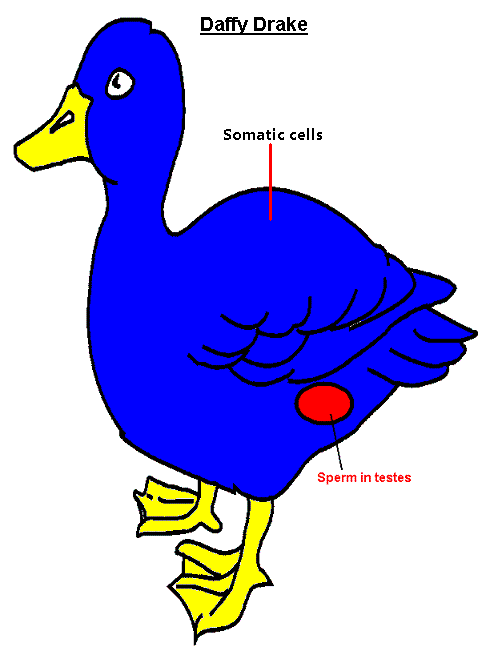
Pink/yellow = somatic cells. Red = egg (ova) cells (in ovaries)
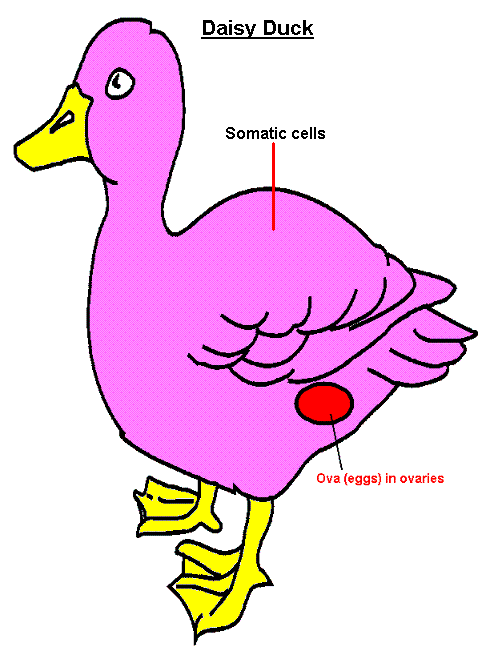
Within both groups of cells (somatic & gamete) are nuclei, & within the nuclei are the Chromosomes (ie long strands of DNA). Chromosomes are composed (in part) of many genes, ie, units of heredity that code for all of the genetic traits in the living organism, for example, shape, size, & colour. In Ducks, Somatic cells have 80 chromosomes or 40 pair, while the Gametes only have 40 chromosomes in total ie only one chromosome from each pair. See diagram below:-
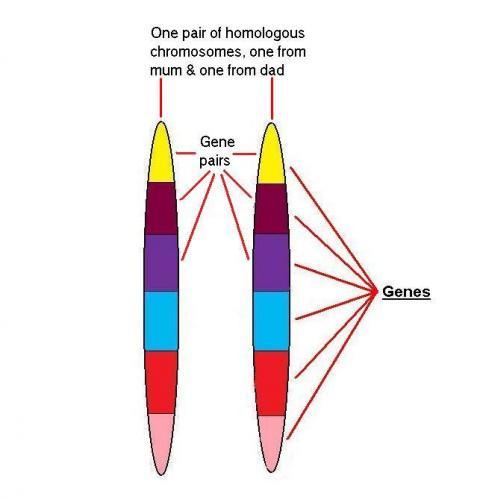
The Somatic cells divide in such a way (Mitosis) that they retain two copies of each chromosome (diploid number) ie the chromosomes occur in homologous pairs. One member of each pair comes from the father, while the other member of each pair comes from the mother:-
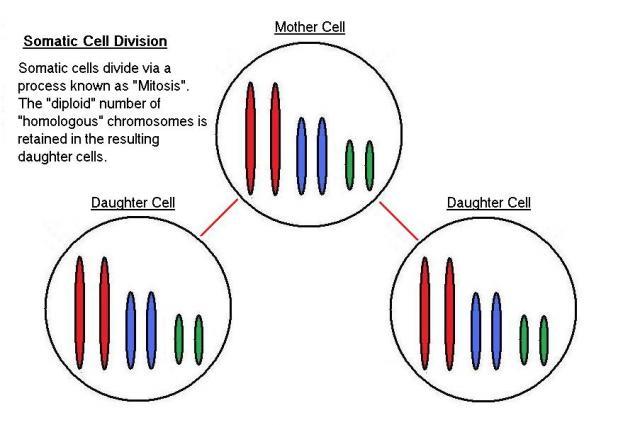
Some pairs of chromosomes in somatic cells: taken from http://commons.wikimedia.org/wiki/File:Karyotype_color_chromosomes_white_background.png)
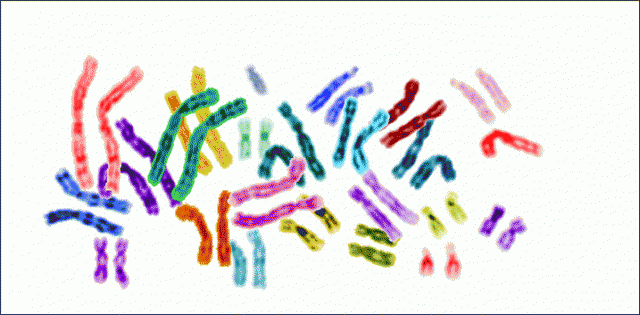
But the Gametes have divided in such a way (Meiosis) that they each only have one copy of each pair (haploid number) of chromosomes that usually occur in the somatic cells:-
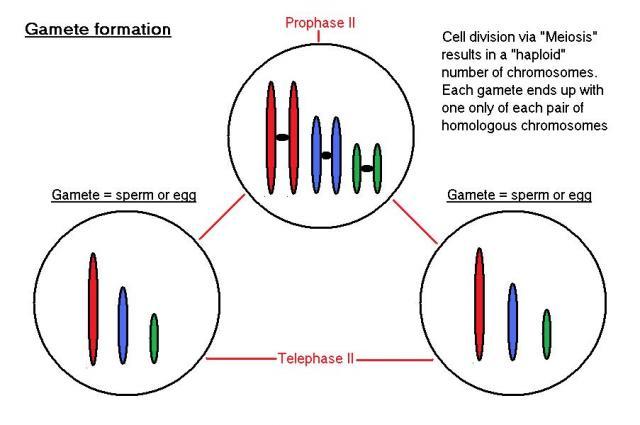
How the Body Works : Gamete Cells
And a diagram of a human sperm & egg with their half compliments of chromosomes for example only: taken from http://members.cox.net/amgough/Fanconi-genetics-genetics-primer.htm
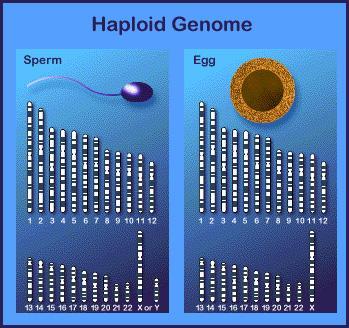
While many of the specialized somatic cells continue to divide & maintain the various body tissues, it is the gametes which transfer the genetic material from both parents to the new life via chromosomes/genes. When the gametes (sperm & egg) fuse @ fertilisation, the diploid number or pairs of chromosomes are again restored in the first new cell (Zygote) of the new life. See digram below:-
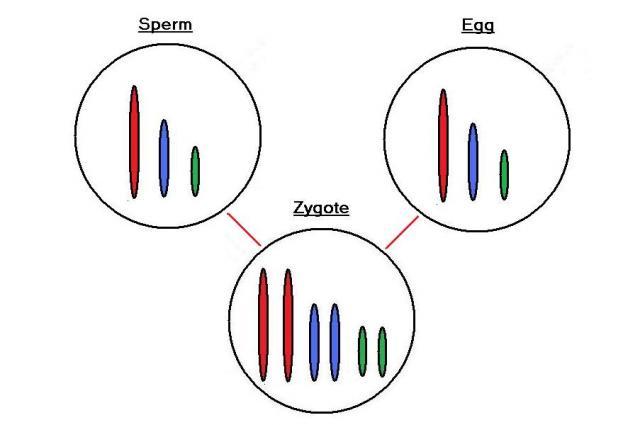
Gene & Chromosome pairs, plus brief introduction to Dominant/Recessive states
Genes, like chromosomes, usually occur in pairs. Genes which occur @ the same position (locus) on a pair of homologous chromosomes are called alleles. An allele is one of two or more alternative forms of a gene @ any given locus. See diagram below:-
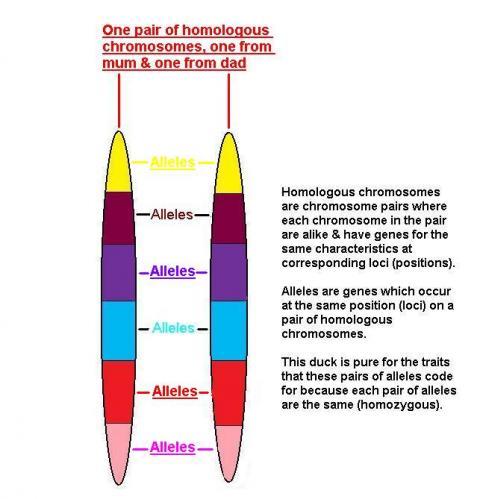
Alleles which are of the same form & code for the same trait are said to be homozygous, while Alleles which are of a different form & code for different traits are said to be heterozygous. See diagram below:-
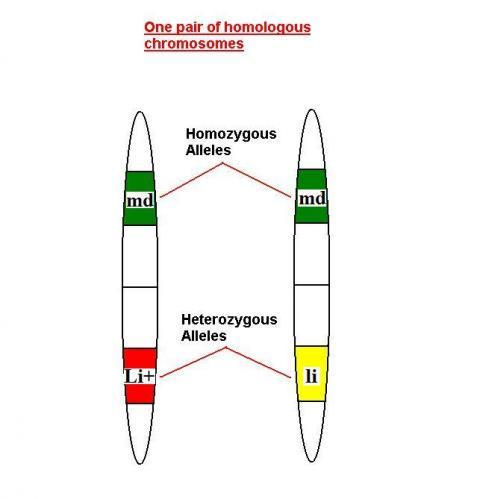
Some alleles are more dominant than others. See tutorial & diagrams below:-
Incomplete Dominance and Codominance - A Quick Tutorial
For the trait to express (be seen) recessive alleles need to be in the homozygous state (except for sex-linked genes in the female duck). Homozygous recessive white in Mallard derived birds for example:-
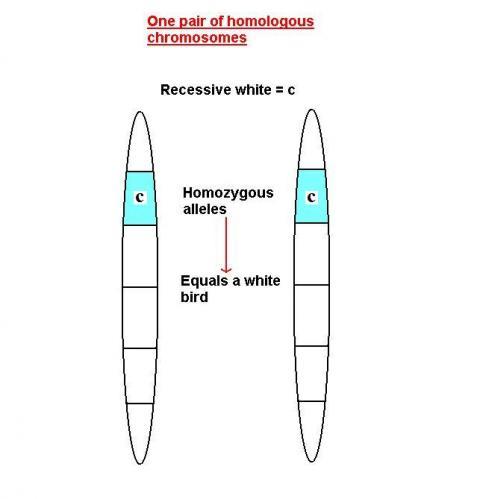
But in the white heterozygote, the more dominant wild-type or "not-white" (C+) gene will express over its recessive white allele (c):-
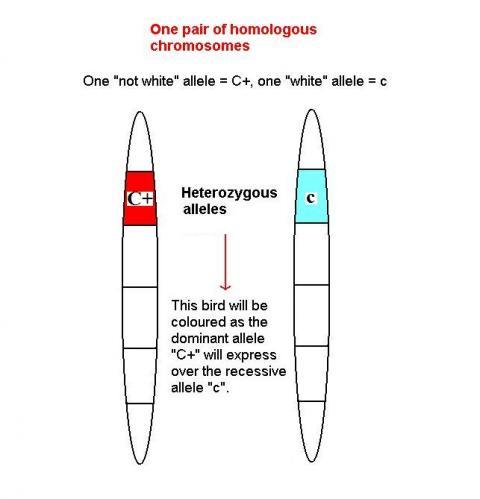
Biology: Mendel: Alternate Alleles
Sex determining Chromosomes, Autosomes, & Sex-Linked Inheritance
Chromosomes are divided into Autosomal Chromosomes & Sex-determining Chromosomes. Autosomal chromosomes are non sex-determining & are all chromosomes that aren't Z or w. The sex-determining chromosomes (Z & w) are sex-determining in that if a new life has only inherited Z sex chromosomes it will be male, but if the new life has inherited both Z & w sex chromosomes it will be female. Male ducks (birds) can only pass Z sex chromosomes to their progeny, both male & female, because being genetically ZZ, they only have Z sex chromosomes to give. Female ducks (birds) can pass on either Z or w sex chromosomes to their progeny because being genetically Zw, they have both Z & w sex chromosomes to give. As such, the mother determines the sex of her young because if she passes on a Z sex chromosome to a duckling it will be a boy (ZZ, Z from dad & Z from mom), but if the mother passes a small w sex chromosome to a duckling it will be a girl (Zw, Z from dad & w from mum).
Paired sex determining chromosomes for ducks (females)
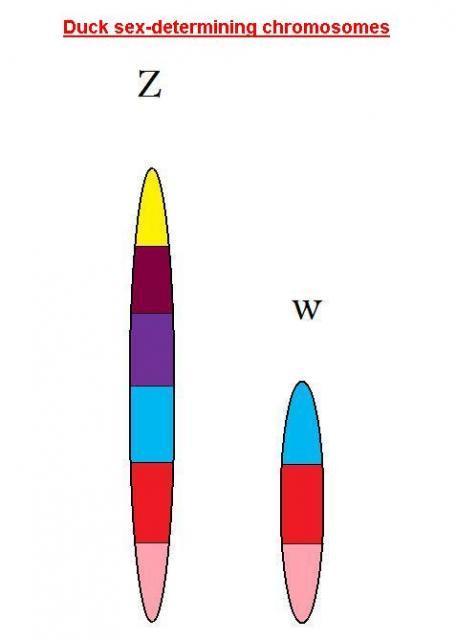
Paired sex determining chromosomes for drakes
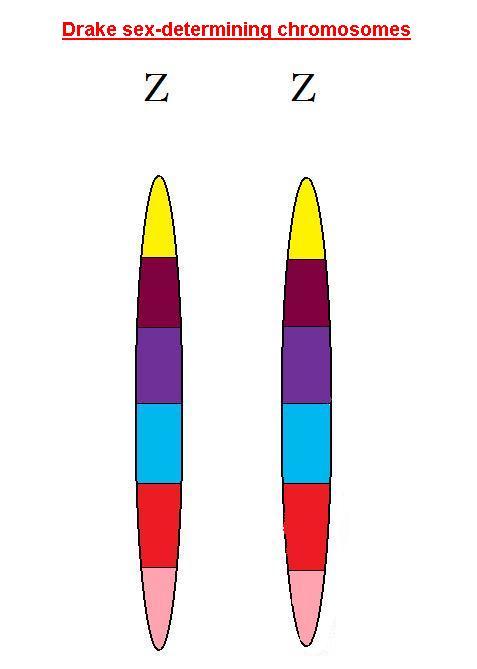
Comparison sample of a drake & ducks diploid chromosomes including sex-determining pairs:-
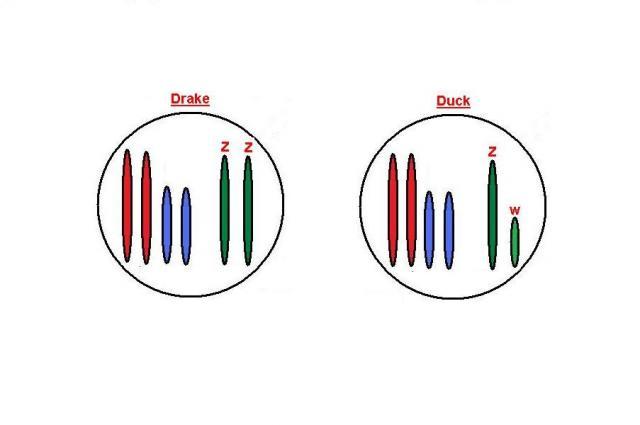
Sex-determining chromosome inheritance as per diagram below:-
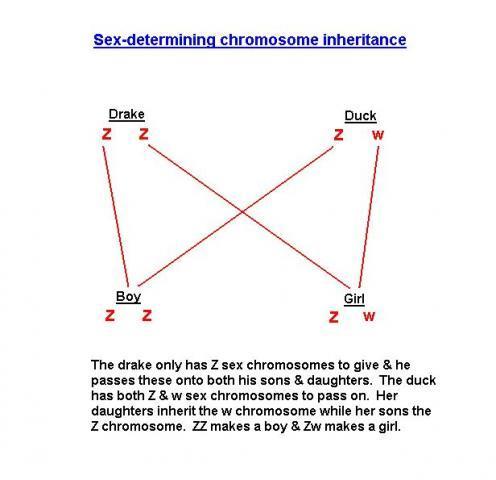
The female is "hemizygous" for the two identified sex-linked colour genes/alleles (bu & Bu+, & d & D+)! This is because the Z sex chromosome inherited from the father has loci for these genes/alleles, but the w sex chromosome inherited from the mother doesn't have the same loci (-), so the d/D+, bu/Bu+ genes/alleles can't be inherited by a daughter from their mothers on the w sex chromosome. Although a female duck does have a pair of sex chromosomes (Zw), she can only ever have one sex linked gene @ each locus for Bu & D. See diagram below:-
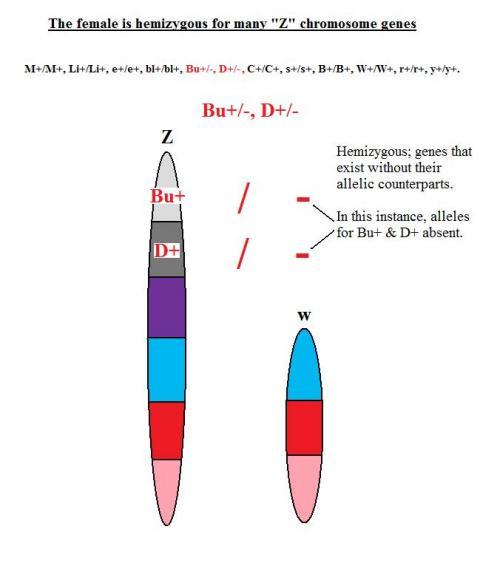
Below are the pair of sex chromosomes for a duck (Zw). On the Z chromosome you will see the recessive brown dilution gene. We know from above that she passes her Z chromosomes onto her sons & her small w chromosomes onto her daughters, so all of her sons will inherit a recessive brown dilution gene but none of her daughters will because the small w chromosomes that she passes to them doesn't have the locus for a recessive brown gene. Although this duck only has the one recessive brown gene (d) on her sex chromosomes the colour will still express because there is no competition from the dominant "not brown" allele (D+).
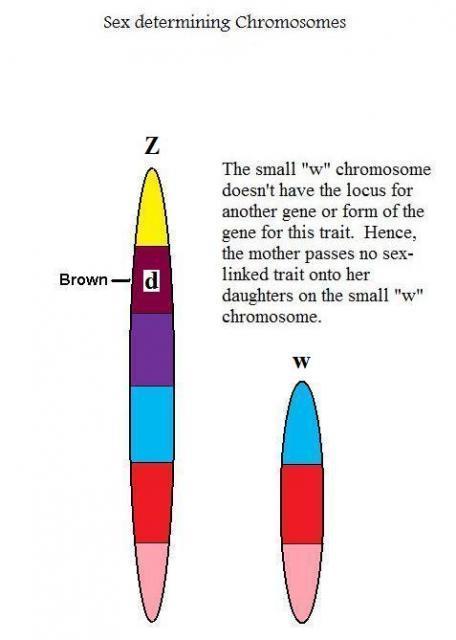
Below are a pair of sex chromosomes from a drake (ZZ). Here you will see that both Z chromosomes have the recessive brown dilution gene. He only has Z chromosomes to give & will pass them plus their recessive brown dilution gene onto both male & female progeny.
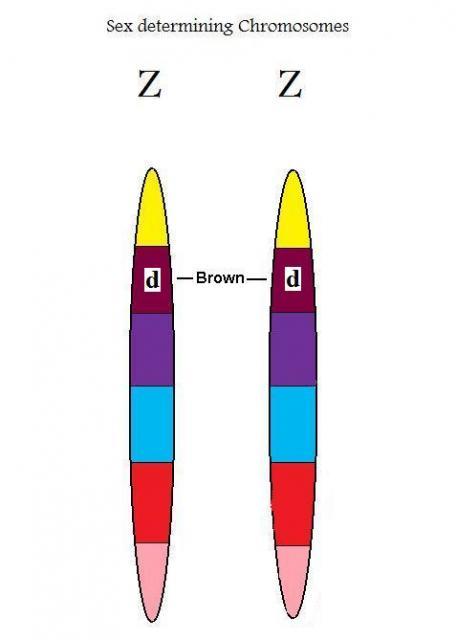
All ducklings produced from the above two "pure for recessive brown dilution gene" birds will inherit the gene. Being a recessive, the males need two doses for the trait to express, while the females, being hemizygous, only require the one dose for the trait to express.
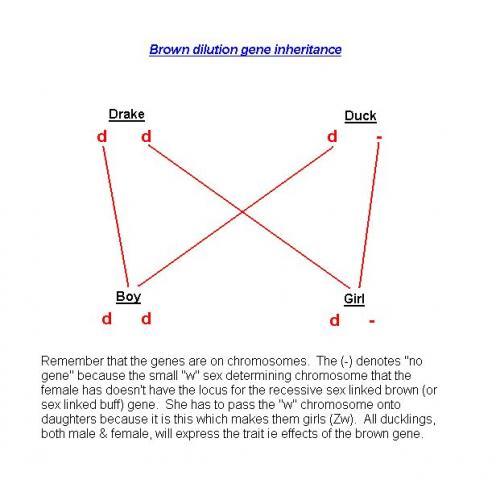
The following pair of birds are different though. This time, the drake is still pure for the sex-linked recessive brown dilution gene (d/d), but the duck has its allele "not brown" or wild-type (D+/-):-
The d/d drake
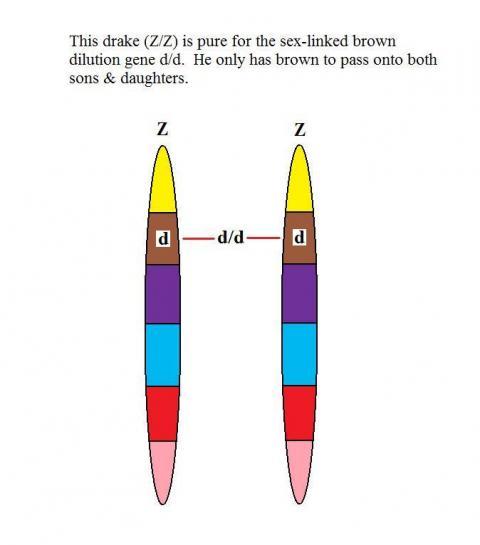
The D+/- duck
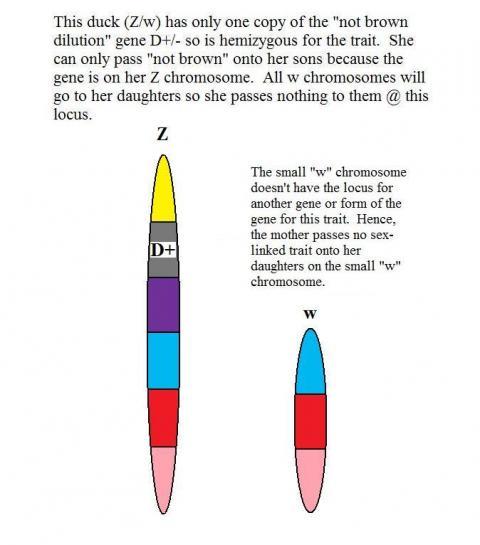
The diagram below shows the sex-linked qualities of such a mating. Female progeny inherit a brown-dilution gene (d) from their father & being hemizygous, nothing (-) from their mother. The colour trait brown will express (if not hidden by white). Male progeny inherit a brown dilution gene (d) from their father, but also the not brown allele (D+) from their mother. Being the dominant allele, "D+" will suppress the action of its recessive brown allele "d", so, drakelets will not express the trait for brown, but they will carry one recessive brown dilution gene hidden.
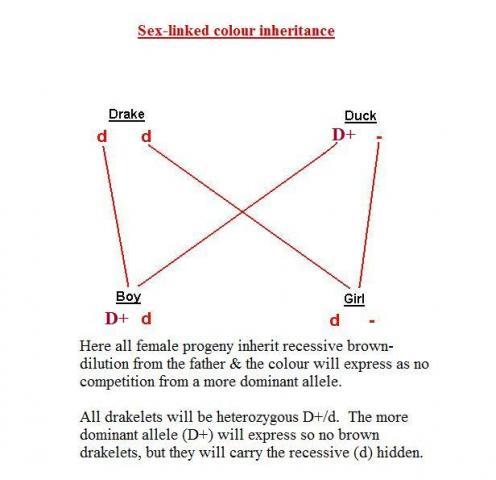
And some photos to help illustrate:-
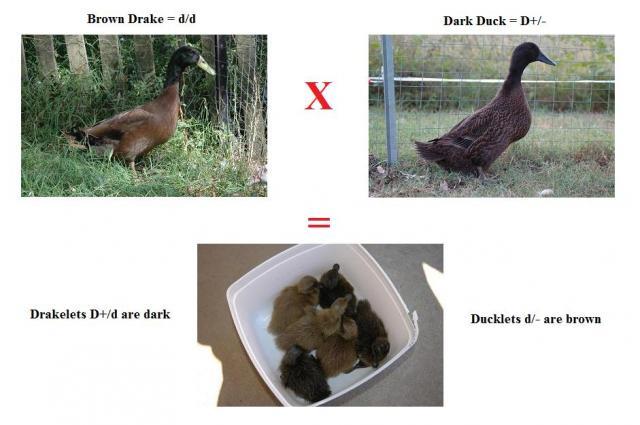
Working with Colour/Pattern Genes of the Mallard derived bird
The genes for colour/pattern in Mallard derived birds follow. They include the wild-type (those genes found in the original wild mallard) as denoted by the (+), & mutations. The alleles have been grouped together eg M+, MR, & md are alleles (according to their loci), with upper case denoting the more dominant allele:-
M+ = Wild-type Mallard
MR = Restricted Mallard
md = Dusky mallard
Li+ = Dark Phase
li = Light Phase
lih = Harlequin Phase
so+ = wild-type
So = Sooty; darkens dusky & wild pattern plumage
e+ = not black
E = Extended Black
bl+ = not blue
Bl = Blue Dilution
D+ = not brown
d = Brown Dilution (sex-linked) {? sex-linked buff dilution allele, ie, wild-type > brown dilution > buff dilution}
Bu+ = not buff
bu = Buff Dilution (sex-linked) {? sex-linked brown dilution allele, ie, wild-type > brown dilution > buff dilution}
C+ = not white
c = recessive white
s+ = not bibbed
S = dominant bib
B+ = not bibbed
b = recessive bib
W+ = not white primaries
w = white primaries
r+ = not pied
R = pied pattern
y+ = normal yellow skin & bill colour
Y = white skin & bill
sd+ = not solid dark bill
Sd = solid dark bill colour {? in the presence of dark phase genes only, ie, light/harlequin phase gene combinations epistatic to "heterozygous" Sd/sd+ resulting in birds exhibiting light (generally) coloured bills?}
The full sequence of colour/pattern genes for a Mallard drake that is pure for wild-type may look something like this:-
M+/M+, Li+/Li+, e+/e+, bl+/bl+, D+/D+, Bu+/Bu+, C+/C+, s+/s+, B+/B+, W+/W+, r+/r+, y+/y+.
And the full sequence of colour/pattern genes for a Mallard duck that is pure for wild-type may look something like this:-
M+/M+, Li+/Li+, e+/e+, bl+/bl+, D+/-, Bu+/-, C+/C+, s+/s+, B+/B+, W+/W+, r+/r+, y+/y+.
Often when discussing the colour/pattern genotype of birds we dont see or use the full sequence of genes, but rather, a shorthand version. So instead of for example (drake):-
md/md, Li+/Li+, e+/e+, Bl/bl+, d/d, bu/bu, C+/C+, s+/s+, B+/B+, W+/W+, r+/r+, y+/y+
we may only see:-
md/md, Bl/bl+, d/d, bu/bu
Why? Because only the genes that deviate from the wild-type, ie, the mutations, really need to be listed as the remainder of the colour genotype is assumed to be wild-type.
When we see strings of letters like those above we are simply looking @ genes on chromosomes. For example, M+/md represents a pair of genes on a pair of chromosomes @ a specific locus seperated by a forward slash (/). One chromosome/gene has been inherited from one parent & the other chromosome/gene has been inherited from the other parent ie M+ is the wild-type gene (on its chromosome) inherited from one parent, & md is a mutated gene inherited from the other parent (on its chromosome). This pair of genes are alleles because they occur @ the same position (locus) on the pair of homologous chromosomes. See diagram below:-
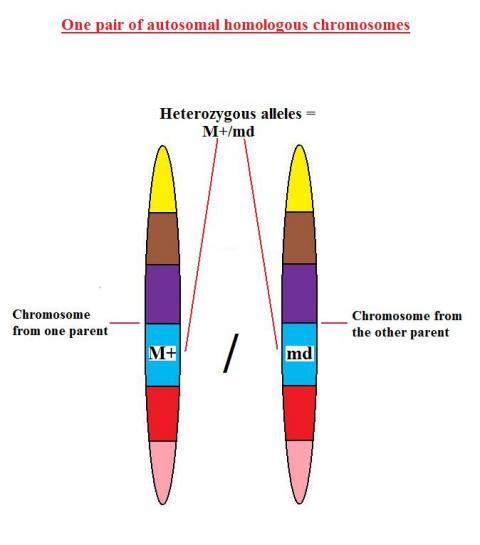
The Mallard Series Alleles (wild-type = M+, restricted = M^R, dusky = m^d)
The Mallard series alleles influence pattern/colour as per the following:-
Wild-Type Mallard (M+); ducklings exhibit the typical camouflage pattern as seen in the wild-type young including ocular stripes (eye-lines), four dorsal spots & ventral yellow. The dorsal surface down colour has been described as "olivacious black". As adults, the female typically has the eye-stripes & brown pencilled plumage, while the drake has the full hood, claret breast, & neck ring in nuptial plumage.
Restricted Mallard (M^R); most evident in the ducklings down, the restricted gene restricts superficial dorsal surface dark down pigmentation to the head (mohark) & tail areas with some variation occuring. Investigating deeper into the down will show a darker undercolour. In the adults the main variation from wild-type is seen in the wing fronts/bows (smaller coverts) with more white being evident.
Dusky Mallard (m^d); dusky duckling down pattern varies considerably from the wild-type mallard & restricted mallard above. Dark pigment is extended uniformly over the dorsal surface with no evidence of facial markings & dorsal spots being evident. Ventral surface areas, although lighter, still exhibit colour other than dull yellow, with bill & legs being dark-ish also. As adults, the males in nuptial plumage lack claret breast & neck rings (dark phase), & the speculum (iridescent wing bars) are obscured & less clearly defined. Dusky females (& males in eclipse plumage) lack the eye-stripes, & both sexes are pigmented underwing (dark & light phase).
Mallard Series Alleles discussed in more detail here (PDF) http://www.genetics.org/cgi/reprint/19/4/310.pdf
The Phase Alleles (dark phase = Li+, light phase = li, harlequin phase = li^h)
Generally, the effect of the phase alleles(Li+, li, lih) on the mallard series alleles (M+, MR, md) is to progressively lighten/brighten, or increase the amount of white, usually very noticable on the females, but other colour/pattern traits are also altered. Some examples using the wild-type mallard (M+) gene & each of the phase alleles to demonstrate:-
M+/M+, Li+/Li+ = a dark phase wild-type mallard eg Rouen or Grey Mallard. Typically the darkest females http://www.feathersite.com/Poultry/Ducks/Rouens/BRKRouens.html
M+/M+, li/li = light phase wild-type mallard eg Trout Runner or Rouen Claire. Lighter than above http://www.feathersite.com/Poultry/Ducks/RouenClair/BRKRouenClair.html
M+/M+, li/lih (theoretically) = light/harlequin phase wild-type mallard eg Australian Spotted. The lightest/brightest of the three http://www.avianweb.com/australianspottedducks.html
I usually think of the mallard series alleles (MR, M+, md) & the phase alleles (Li+, li, lih) as the base genes & those I begin with when building/creating the colour/pattern of a bird. They can occur in any combination resulting in the varied & "off" phenotypes that we see when impure. The mutations @ the other loci when added contribute to the wonderful array of colour & pattern in mallard derives breeds/varieties.
A few examples using base series (MR, M+, md) & phase (Li+, li, lih) genes to illustrate. Remember, when using shorthand those gene pairs not listed are assumed to be wild-type:-
1/ M+/M+, Li+/Li+ = dark-phase wild-type mallard eg Rouen
2/ M+/M+, li/li = light-phase wild-type mallard eg Trout
3/ M+/M+, lih/lih = harlequin-phase wild-type mallard eg Snowy (per American standard)
4/ MR/MR, Li+/Li+ = non-standard genotype (off-coloured)
5/ MR/MR, li/li = light-phase restricted mallard eg Appleyard
6/ MR/MR, lih/lih = non-standard genotype (off-coloured)
7/ md/md, Li+/Li+ = dark-phase dusky mallard eg Dark Campbell
8/ md/md, li/li = non-standard genotype (off-coloured)
9/ md/md, lih/lih = harlequin-phase dusky mallard eg Abacot Ranger
Now add diluting/pattern modifying genes to a couple of them for example:-
1/ M+/M+, li/li, Bl/Bl = apricot/buff light-phase wild-type mallard eg Saxony
2/ md/md, Li+/Li+, d/d (d/-) = brown dark-phase dusky mallard eg Kharki Campbell
3/ M+/M+, Li+/Li+, Bl/bl+ = blue dark-phase wild-type mallard eg Blue Fawn
4/ md/md, Li+/Li+, d/d (d/-), R/R = brown pied dark-phase dusky mallard eg Fawn & White Runner
Purity & Impurity
The colour/pattern genes which exist in any given bird will influence what we see (phenotype) as regards colour/pattern. When pure for a certain breed colour/pattern, then we should see what we have become accustomed to seeing for that breed. But many times we will see some small variation regardless, possibly due to variable expression of the gene/s or the influence of unknown minor modifiers. Birds that are impure @ one or more loci may also express in "off" colours/patterns. Lets look @ a couple of examples of pure & impure colour genotypes starting with the pure wild-type bird ie the wild Mallard or Rouen. All mutations are in red for ease of identification.
A wild-type coloured/patterned drakes genotype should as we know it be:-
M+/M+, Li+/Li+, e+/e+, bl+/bl+, D+/D+, Bu+/Bu+, C+/C+, s+/s+, B+/B+, W+/W+, r+/r+, y+/y+.
All paired genes in the above genotype are wild-type as designated by the (+) symbol. This bird is pure @ all loci for paired genes because each pair are the same (homozygous), eg M+/M+. There is nothing hidden because all recessive pairs are pure so the trait/s should express, eg e+/e+.
But what about a bird who is impure @ one or more loci? The following drake genotype is impure @ two loci! He is heterozygous Li+/li & C+/c so what will he look like? According to theory, he should really look much like the wild-type Mallard drake above. Both mutations li & c are recessive to their alleles Li+ & C+ so should have little to no influence on phenotype. If we cant see them (heterozygous recessives) but they are there then we could say that they are hidden:-
M+/M+, Li+/li, e+/e+, bl+/bl+, D+/D+, Bu+/Bu+, C+/c, s+/s+, B+/B+, W+/W+, r+/r+, y+/y+.
The following drake is pure @ all loci including the recessive white mutation c, ie, homozygous c/c. When pure, the recessive white gene either inhibits the production of colour (eumelanin & pheomelanin), or it prevents the colour from getting into the feather, so we end up with a bird with no colour, ie a pure for white bird:-
M+/M+, Li+/Li+, e+/e+, bl+/bl+, D+/D+, Bu+/Bu+, c/c, s+/s+, B+/B+, W+/W+, r+/r+, y+/y+.
The following drake has mutations @ two loci! Firstly, he is pure (homozygous) for the extended black mutation gene E, & secondly, he is impure (heterozygous) for the blue dilution mutation gene Bl, so what will he look like? The extended black gene will extend black pigment (eumelanin) throughout the whole bird, so the wild-type coloured/patterned mallard will be turned into a black bird. But he wont remain black because of the blue dilution gene! The blue dilution gene is incompletely dominant, ie, it doesnt completely get rid of the black but only reduces its intensity by inhibiting the amount of eumalanin that gets into the feather, so we end up with a diluted black ie blue/grey:-
M+/M+, Li+/Li+, E/E, Bl/bl+, D+/D+, Bu+/Bu+, C+/C+, s+/s+, B+/B+, W+/W+, r+/r+, y+/y+.
Calculating Probable Outcomes Using Punnett Squares
Punnett Squares are a fun & easy way to calculate the probable trait outcomes of your breeding programs if you know the typical genes & their behaviour in the breeds you keep. A couple of examples using Punnett Squares may help. Mutations will be highlighted in red.
Lets say that we mate a wild-type Mallard drake to a Blue Fawn Mallard duck:-
Drake = M+/M+, Li+/Li+, e+/e+, bl+/bl+, D+/D+, Bu+/Bu+, C+/C+, s+/s+, B+/B+, W+/W+, r+/r+, y+/y+. :-
Duck = M+/M+, Li+/Li+, e+/e+, Bl/bl+, D+/-, Bu+/-, C+/C+, s+/s+, B+/B+, W+/W+, r+/r+, y+/y+.
We want to work out what colours we will get from this cross & we only need to consider the blue (Bl) & the not-blue (bl+) genes (alleles). Using our Punnett Square we can put the drakes alleles down the left hand side & the ducks alleles across the top:-
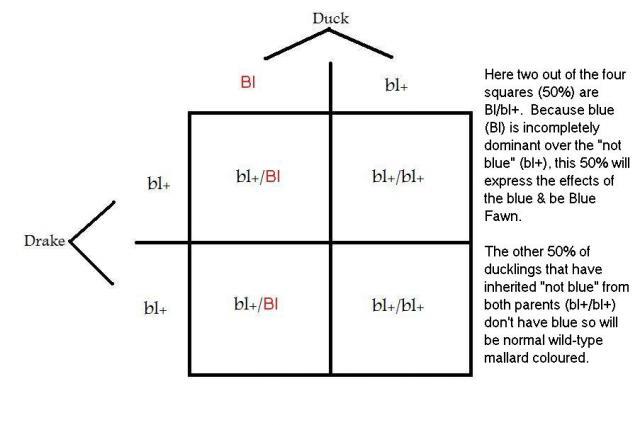
One more example; we breed together two birds that both appear to be pure wild-type Mallards but each carries hidden (heterozygous) a recessive white gene (c):-
Drake = M+/M+, Li+/Li+, e+/e+, bl+/bl+, D+/D+, Bu+/Bu+, C+/c, s+/s+, B+/B+, W+/W+, r+/r+, y+/y+.
Duck = M+/M+, Li+/Li+, e+/e+, bl+/bl+, D+/-, Bu+/-, C+/c, s+/s+, B+/B+, W+/W+, r+/r+, y+/y+.
Using the Punnett Square we learn that 25% of progeny will be pure white, 25% pure for wild-type, & 50% will appear wild-type coloured/patterned birds but will carry heterozygous recessive white hidden.
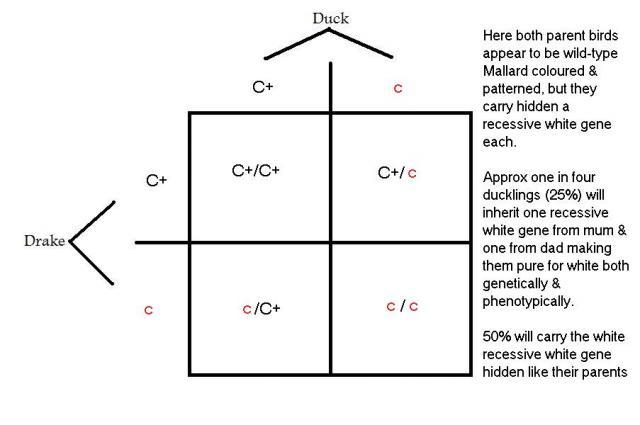
So you see, if we know what colour/pattern genes are in our parent birds & we know how these effect colour/pattern, we can calculate probable outcomes using the Punnett Sqare.
These Youtube clips are also very helpful:-
Gregor Mendel's Punnett Squares
Mendelian Genetics - A Quick Tutorial
Incomplete Dominance and Codominance - A Quick Tutorial
http://www.schooltrainer.com/study-material/biology/punnett-square-fun.html
Some Genotypes with Photo examples
Following are some photos of birds & their theorised genotypes. All mutations are in red for ease of identification. It is worth being aware that genotypes may vary somewhat between breeds with the same hobby name in different countries. Quality for type may not be to standard for some example birds; colour & pattern are the desired features portrayed!
Wild-type Mallard Drake (grey)
M+/M+, Li+/Li+, e+/e+, bl+/bl+, D+/D+, Bu+/Bu+, C+/C+, s+/s+, B+/B+, W+/W+, r+/r+, y+/y+.
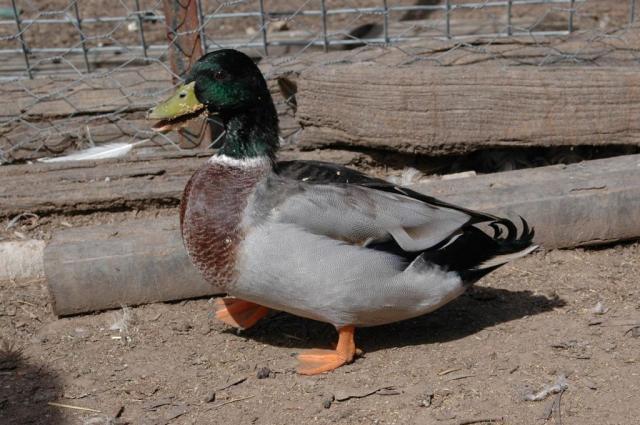
Wild-type Mallard Duck (grey)
M+/M+, Li+/Li+, e+/e+, bl+/bl+, D+/-, Bu+/-, C+/C+, s+/s+, B+/B+, W+/W+, r+/r+, y+/y+.
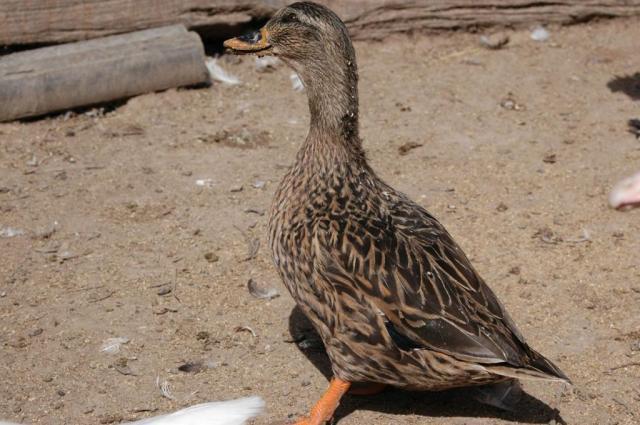
Kharki Campbell Drake (dark phase dusky + brown dilution)
md/md, Li+/Li+, e+/e+, bl+/bl+, d/d, Bu+/Bu+, C+/C+, s+/s+, B+/B+, W+/W+, r+/r+, y+/y+.
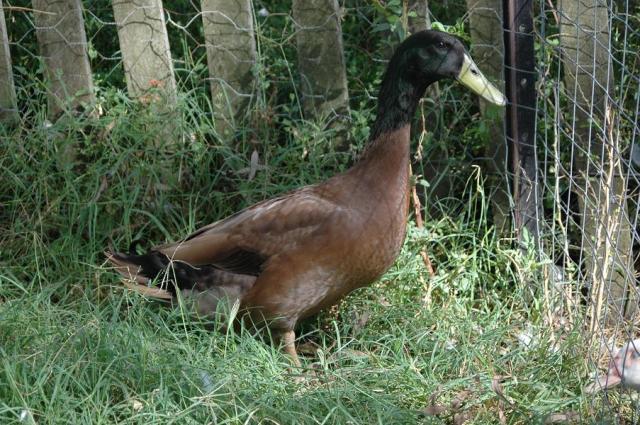
Kharki Campbell Duck (dark phase dusky + brown dilution)
md/md, Li+/Li+, e+/e+, bl+/bl+, d/-, Bu+/-, C+/C+, s+/s+, B+/B+, W+/W+, r+/r+, y+/y+.
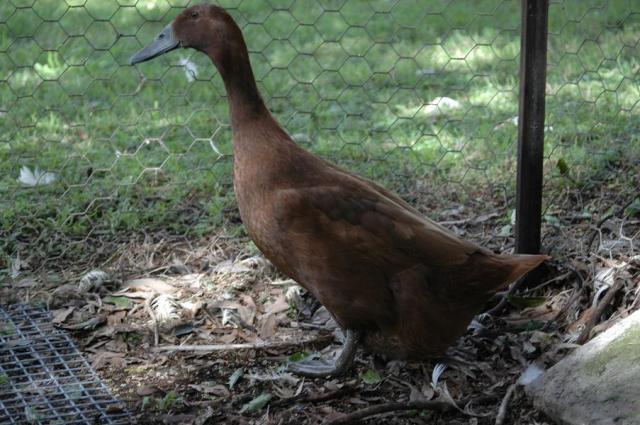
Dark Campbell Drake (dark phase dusky) (this bird = D+/d)
md/md, Li+/Li+, e+/e+, bl+/bl+, D+/D+, Bu+/Bu+, C+/C+, s+/s+, B+/B+, W+/W+, r+/r+, y+/y+.
Dark Campbell Duck (dark phase dusky)
md/md, Li+/Li+, e+/e+, bl+/bl+, D+/-, Bu+/-, C+/C+, s+/s+, B+/B+, W+/W+, r+/r+, y+/y+.
Fawn & White Runners (dark phase dusky + brown dilution + runner pattern (USA = add homo blue))
md/md, Li+/Li+, e+/e+, bl+/bl+, d/d, (d/-), Bu+/-, C+/C+, s+/s+, B+/B+, W+/W+, R/R, y+/y+.
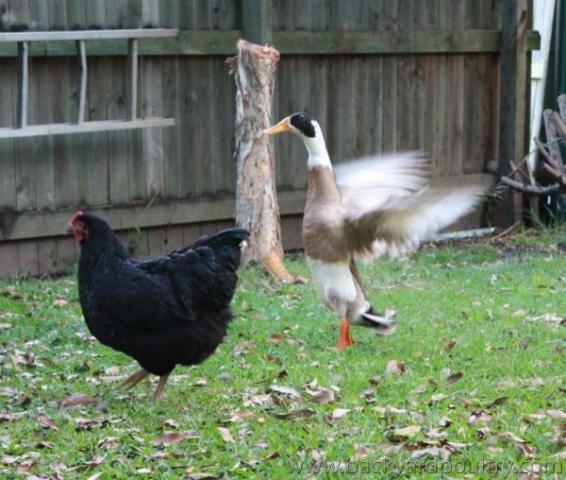
With thanks to Roova
Silver Appleyard Drake (light phase resticted mallard)
MR/MR, li/li, e+/e+, bl+/bl+, D+/D+, Bu+/Bu+, C+/C+, s+/s+, B+/B+, W+/W+, r+/r+, y+/y+.
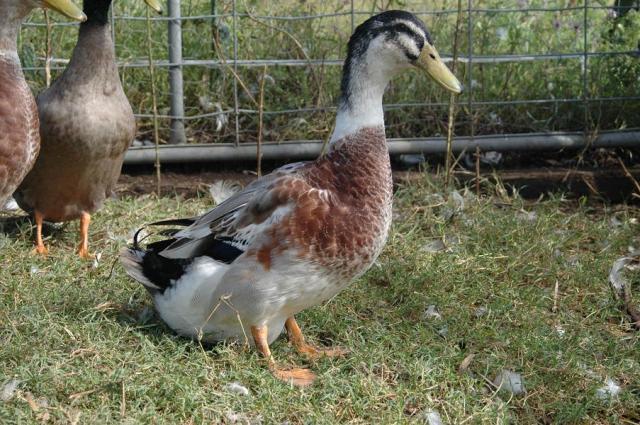
Silver Appleyard Duck (light phase resticted mallard)
MR/MR, li/li, e+/e+, bl+/bl+, D+/-, Bu+/-, C+/C+, s+/s+, B+/B+, W+/W+, r+/r+, y+/y+.
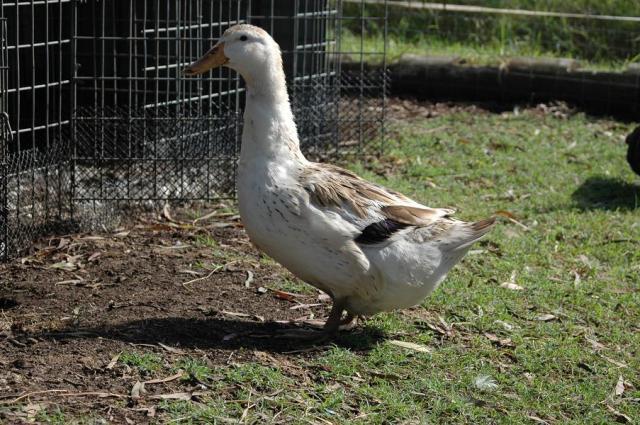
Saxony Drake (light phase wild-type mallard + homo blue dilution)
M+/M+, li/li, e+/e+, Bl/Bl, D+/D+, Bu+/Bu+, C+/C+, s+/s+, B+/B+, W+/W+, r+/r+, y+/y+.
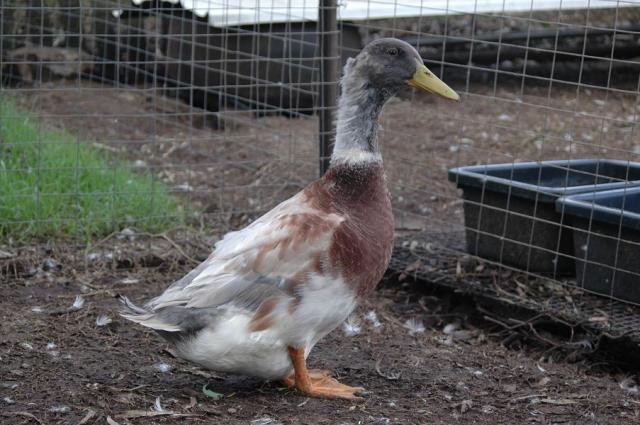
Saxony Duck (light phase wild-type mallard + homo blue dilution)
M+/M+, li/li, e+/e+, Bl/Bl, D+/-, Bu+/-, C+/C+, s+/s+, B+/B+, W+/W+, r+/r+, y+/y+.
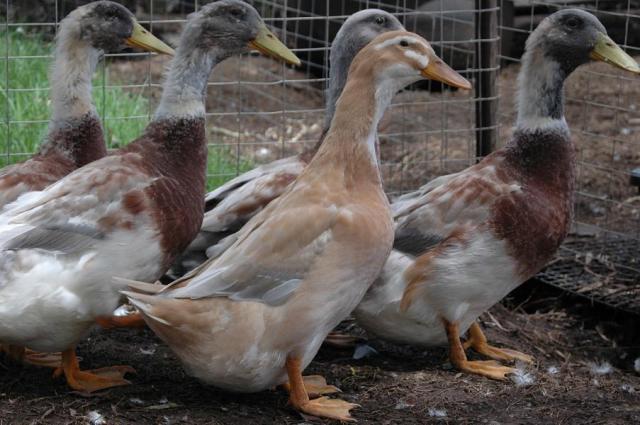
Trout (light phase wild-type mallard)
M+/M+, li/li, e+/e+, bl+/bl+, D+/D+, Bu+/Bu+, C+/C+, s+/s+, B+/B+, W+/W+, r+/r+, y+/y+.
Photo wanted
Blue Trout (light phase wild-type mallard + hetero blue dilution)
M+/M+, li/li, e+/e+, Bl/bl+, D+/D+, Bu+/Bu+, C+/C+, s+/s+, B+/B+, W+/W+, r+/r+, y+/y+.
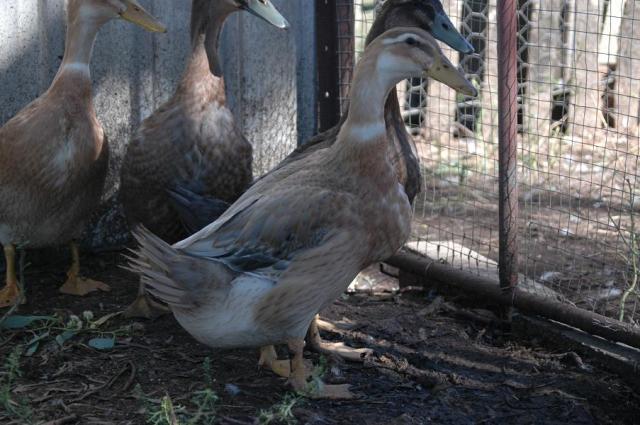
Blue Fawn (dark phase wild-type mallard + hetero blue dilution) (these are M+/m^d, Li+/li, Bl/bl+)
M+/M+, Li+/Li+, e+/e+, Bl/bl+, D+/D+, Bu+/Bu+, C+/C+, s+/s+, B+/B+, W+/W+, r+/r+, y+/y+.
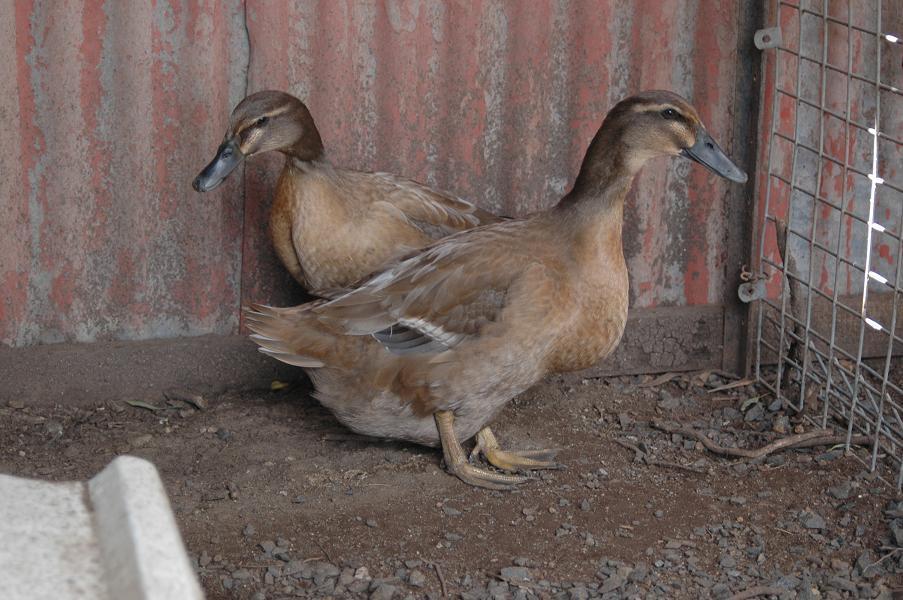
Pastel (dark phase wild-type mallard + homo blue dilution)
M+/M+, Li+/Li+, e+/e+, Bl/Bl, D+/D+, Bu+/Bu+, C+/C+, s+/s+, B+/B+, W+/W+, r+/r+, y+/y+.
Photo wanted
Harlequin (harlequin phase dusky)
md/md, lih/lih, e+/e+, bl+/bl+, D+/D+, Bu+/Bu+, C+/C+, s+/s+, B+/B+, W+/W+, r+/r+, y+/y+.
Photo wanted
Harlequin (harlequin phase dusky + brown dilution)
md/md, lih/lih, e+/e+, bl+/bl+, d/d, (d/-), Bu+/Bu+, C+/C+, s+/s+, B+/B+, W+/W+, r+/r+, y+/y+.
Photo wanted
Buff Orpington (dark phase dusky + brown, buff, + hetero blue dilution)
md/md, Li+/Li+, e+/e+, Bl/bl+, d/d, (d/-), bu/bu, (bu/-), C+/C+, s+/s+, B+/B+, W+/W+, r+/r+, y+/y+.
Photo wanted
Blue (extended black + hetero blue dilution)
E/E, Bl/bl+, D+/D+, Bu+/Bu+, C+/C+, s+/s+, B+/B+, W+/W+, r+/r+, y+/y+.
Photo wanted
Silver/Splash (extended black + homo blue dilution)
E/E, Bl/Bl, D+/D+, Bu+/Bu+, C+/C+, s+/s+, B+/B+, W+/W+, r+/r+, y+/y+.
Photo wanted
Chocolate (extended black + sex-linked brown dilution)
E/E, bl+/bl+, d/d, (d/-), Bu+/Bu+, C+/C+, s+/s+, B+/B+, W+/W+, r+/r+, y+/y+.
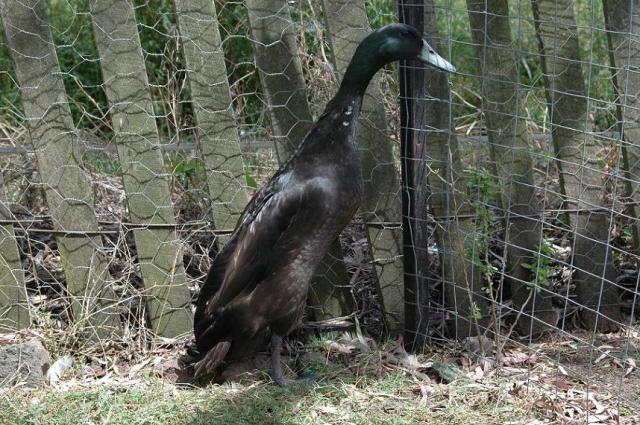
Bibbed (any colour + gene for bibbing)
M+/M+, Li+/Li+, e+/e+, bl+/bl+, D+/D+, Bu+/Bu+, C+/C+, S/S, B+/B+, W+/W+, r+/r+, y+/y+.
Photo wanted
Runner Pattern (any colour + pied/runner pattern gene)
md/md, Li+/Li+, e+/e+, bl+/bl+, d/d, (d/-), Bu+/Bu+, C+/C+, s+/s+, B+/B+, W+/W+, R/R, y+/y+.
Photo wanted
Magpie Pattern (any colour + pied/runner pattern + bibbed genes)
E/E, bl+/bl+, D+/D+, Bu+/Bu+, C+/C+, S/S, B+/B+, W+/W+, R/R, y+/y+.
Photo wanted
White
Epistatic to "colour/pattern" when homozygous. With birds that are pure for the recessive white gene it doesn't matter what "colour" or "pattern" genes exist because the expression of both will be inhibited, hence, a white (no colour) plumaged bird will result.
c/c.
Photo wanted
Black
Extended black will turn all pigmented areas to black. Both homozygotes & heterozygotes are affected (although unsure as to just how completely heterozygotes are affected?). Homozygous recessive white (c/c) will turn a black bird to white. Diluters & Pattern genes will influence colour/pattern.
E/E, bl+/bl+, D+/D+, Bu+/Bu+, C+/C+, s+/s+, B+/B+, W+/W+, r+/r+, y+/y+.
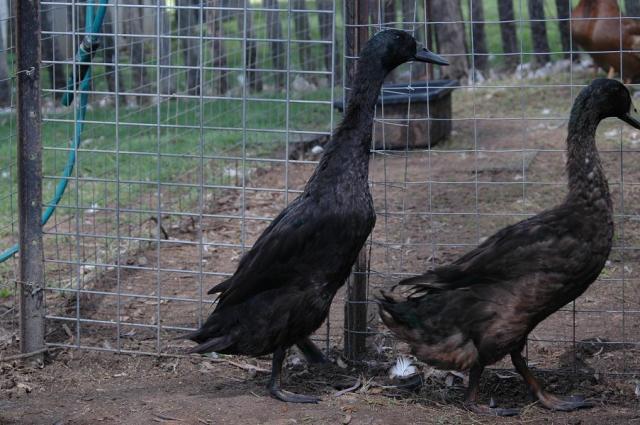
References
"Poultry breeding and genetics", By Roy D. Crawford, pp 381-387.
Poultry Genetics for the Nonprofessional, Sellers family http://sellers.kippenjungle.nl/page0.html
http://kippenjungle.nl/Overzicht.htm#kipcalculator
"Mosbys Medical, Nursing, & Allied Health Dictionary", 1994
"Stories Guide to Raising Ducks", Holderread, 2001.
http://www.ansi.okstate.edu/resource-room/genetics/all/chromosome.htm
"Colour Breeding in Domestic Ducks", Mike & Chris Ashton, 2007
The Domestic Duck", Chris & Mike Ashton, 2008
http://www.genetics.com.au/pdf/factsheets/fs01.pdf
http://www.ansi.okstate.edu/resources/genetic/diploid-chromosome-numbers-in-some-familiar-animals
"Biology: Concepts & Aplications", by Cecie Starr, Wadsworth Publishing Company, California, 1991.
Edited to correct error/add photos
Last edited:




